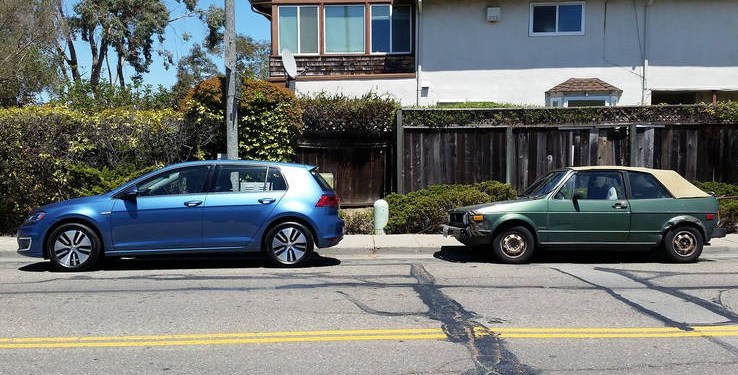In which your Junkyard Scavenger stretches the limits of the e-Golf’s range in order to add to his hoard of weird 1980s Japanese electronics.
The San Francisco Bay Area is a fine place to drive electric cars; the mild weather means you can leave the battery-draining HVAC system shut off, the area’s urban core is fairly dense, fuel prices are high, and you can find charging stations all over the place. I visited the area for a 24 Hours of LeMons brain-trust meeting in June and got around in a Fiat 500e done up in dazzling Arancio Elettrico paint. Last week, I returned to visit family and opted for an equally electric yet more sensible-seeming 2015 VW e-Golf SEL Premium.
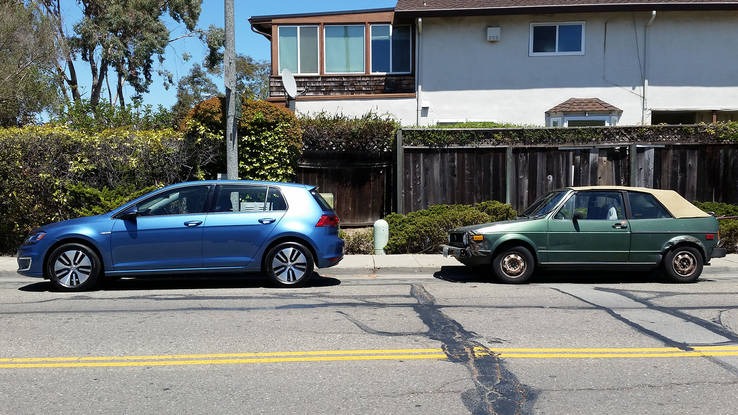
The Golf has put on a few pounds since the early 1980s.
Back when I lived in the island city of Alameda, California, I’d photograph interesting street-parked cars (which abound on the island). When I return there with a car to review, I always look for an older version of the same vehicle for a photograph. As you can see, this 1982 Volkswagen Rabbit cabrio is quite a bit smaller than its 21st-century counterpart.
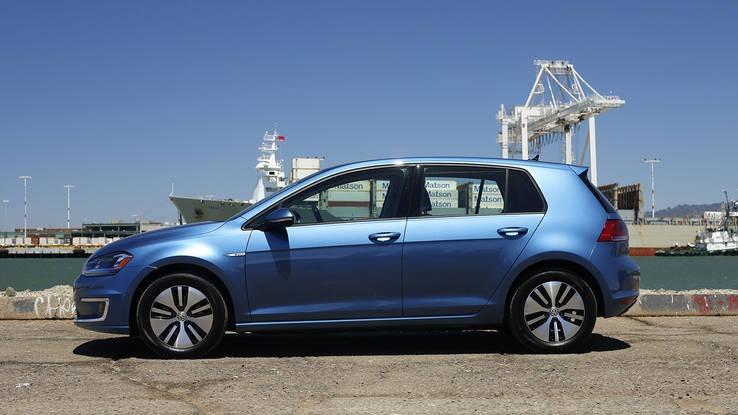
Few of us actually want to go back to driving cars as small as the miserably cramped Mk1 Golf.
The e-Golf seemed very competent, with plenty of space for cargo and passengers and all that sensible stuff… but in the Bay Area, EV buyers tend to want to let the world know of their greenness and/or generally futuristic outlook. The e-Golf doesn’t offer much clue that it doesn’t run on internal combustion, so it fails an important image test that (I suspect) must be quite important to Bay Area EV shoppers. Perhaps a big hood mural showing Hans Ledwinka Ferdinand Porsche hurling lightning bolts, Wotan-style, into the cringing face of a crude-spewing monster representing Big Oil would help. The other problem I saw was a rental-car-grade lack of personality of any sort, which feels like being told to eat your vegetables and go to bed early… right after the Fiat 500e let you ride the Tilt-a-Whirl twenty times in a row and then eat a whole jar of Nutella.
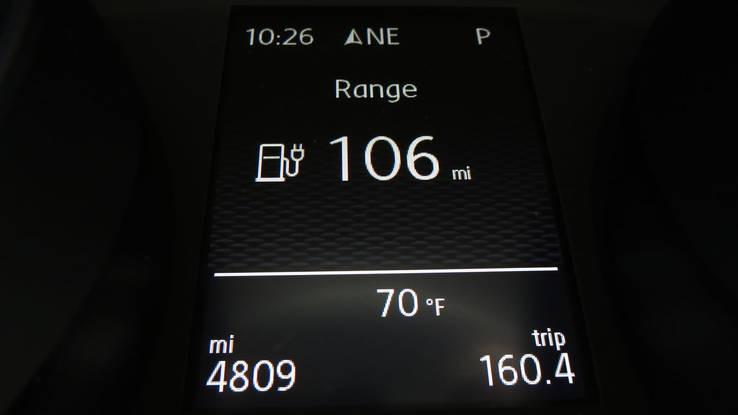
Volkswagen (actually, the EPA) says this car will go 83 miles on a charge, but the Range-O-Meter starts out with more optimism.
I’d received an alert from Row52 that a 1984 Nissan Maxima had entered the inventory of a self-service wrecking yard in San Jose, and that meant that I had to get there and extract its phonograph-record-based voice warning system box for my collection. From Alameda to this yard was about 37 miles, placing the round-trip within the theoretical range of the e-Golf. What could go wrong?
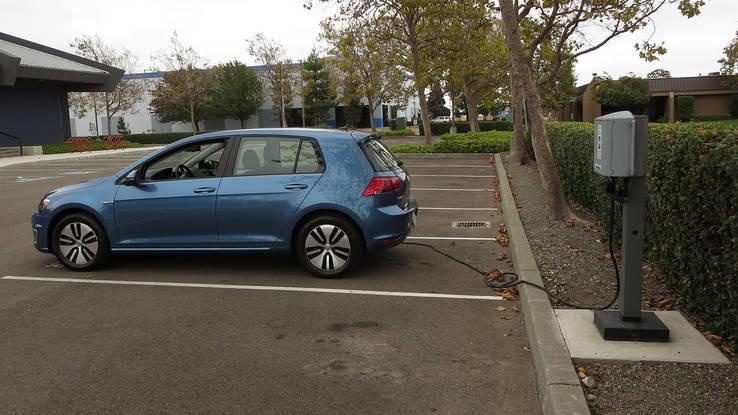
Just to be on the safe side, I stopped at a free charging station to top off the battery early in my journey.
After the unsettling all-over-the-place predictions of the Fiat 500e’s Range-O-Meter, I decided to assuage the Range Anxiety Demons by stopping about ten miles into my journey and topping off the batteries at a conveniently located free charging station. This being Sunday, I had the place to myself. As it turned out, the e-Golf doesn’t subject the driver to any massive changes in its predicted range, nor does it base that range upon assumptions of 47 mph cruising speeds and/or tectonic-plate-style acceleration.

Yes, the Voice Alert System unit was still inside, and I bought it.
I made it to the wrecking yard, pulled the sixth Nissan Voice Warning box for my collection (I have a ridiculous project in mind for them, though it stings that my friend Jason Torchinsky has outdone even my worst project ideas with his latest work), and found that there had been no need to add that extra ten miles of range. The e-Golf would have done the 74-mile round trip with a good 12 miles to spare on the batteries even without my fearful charge-up. Granted, I left the AC and headlights turned off and the car in “Eco” mode (I’d started in “Eco+” mode, but shut it off as soon as I realized that this setting limits the top speed to 60 mph), but such range accuracy is a huge plus in an electric car.
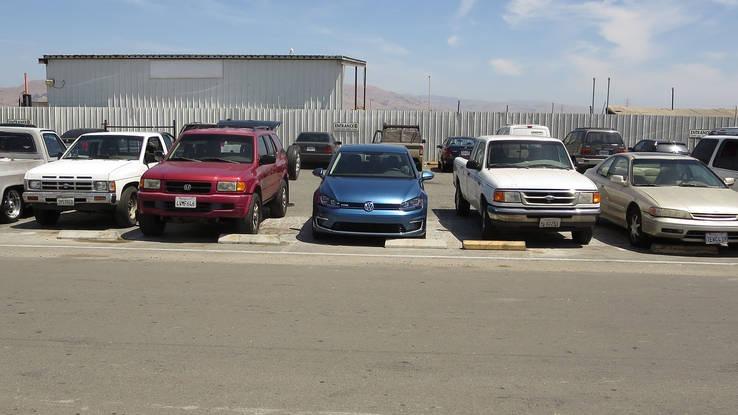
It’s a bit shiny for the junkyard parking lot, but it doesn’t attract attention with its EV-ness.
The e-Golf demonstrates that there’s nothing particularly edgy about some electric cars now; it drives like a regular car (albeit with the extra 15-to-40 mph push that you get with electric-motor torque), it does everything the dino-juice-burning Golf does (except take long road trips), and it’s sort of boring like a regular car. The level of conscience-soothing greenness depends on how your electricity is generated; if it comes from coal— as much American electricity does— then this car isn’t much of a carbon- and smog-emissions improvement over an ordinary internal-combustion Golf. If it comes from a mix of sources that includes geothermal, nuclear, wind, coal, and natural gas (as most Northern California power does), then you’ll need a phalanx of scientists to sort out the environmental impact of your decision to purchase an e-Golf.
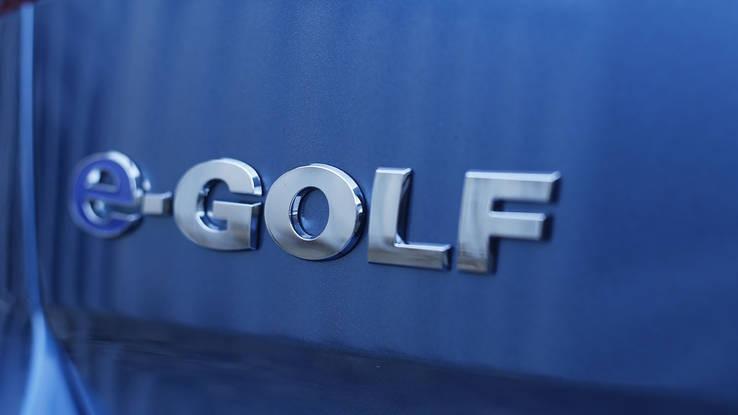
The e-Golf emblems are subtle.
Overall, the e-Golf does what a car is supposed to do, though without being much fun in the process. The Range-O-Meter is quite accurate (under the not-so-demanding conditions to which I subjected it). The car had some rattles and squeaks at speed that may or may not have been audible over the noise of a gasoline engine but were quite apparent with the quiet electric powertrain, and I felt a sense of low-bidderness about some of the switches and controls. Utter lack of frivolity, along with a lack of blaring EV-smugness. I think I’d take the 500e over the e-Golf, but that’s mostly due to pro-Italian-car bias on my part.

